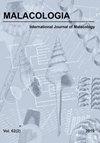食肉腹足动物棘足动物捕食策略的个体发生变化(Pallas, 1774)
IF 1
4区 生物学
Q4 ZOOLOGY
引用次数: 10
摘要
腹足类食肉动物的捕食策略在个体发育过程中可能发生变化。在腹足类动物中,攻击机制包括副无聊器官(ABO)、radula、唇牙和/或足部肌肉。然而,这些机制和它们的使用模式在肉食性腹足动物的个体发育中仍然不确定。本文通过腹足类棘鱼(Acanthina monodon)捕食紫贻贝(Perumytilus purpuratus)的个体发生过程,研究了捕食策略发生变化的过程。我们的研究结果显示了捕食者和猎物大小之间的直接关系。在攻击过程中,小螺(18 mm以下)只使用ABO,而中型螺(18 - 20 mm)则转向使用radula来刮壳。与此同时,最大的蜗牛(大约20毫米长)使用齿髓,但偶尔也使用足部肌肉和唇牙来攻击猎物。根据所使用的捕食性机制,myliids壳上的位点选择性不同。小型腹足类动物用ABO钻食瓣膜的中心,而大中型蜗牛则在瓣膜边缘上钻食radula和唇牙。偶尔,大型蜗牛也使用ABO。随着捕食者体型的增加,参与攻击的结构的发展和巩固影响了捕食策略和攻击区域的变化。拉氏齿生长过程中微量元素的加入可能使其对碳酸盐猎物阀的摩擦产生主要阻力,以及唇牙的外观和发育在捕食机制转变中发挥了相关作用,从而使其能够消耗更大的猎物。这些模式描述了腹足类动物捕食行为的证据,从能量获取的角度来看,同时将捕食者自己被捕食的风险降到最低。本文章由计算机程序翻译,如有差异,请以英文原文为准。
Ontogenetic Shifts of Predatory Strategies by the Carnivorous Gastropod Acanthina monodon (Pallas, 1774)
ABSTRACT Predatory strategies used by carnivorous gastropods may change during their ontogeny. In muricid gastropods attack mechanisms include an accessory boring organ (ABO), radula, labral tooth and/or pedal muscle. However, these mechanisms and their patterns of use in relation to the ontogeny of the carnivorous gastropod remain uncertain. We studied the occurrence of shifts in predatory strategies through the ontogeny of the gastropod Acanthina monodon preying on the mytilid Perumytilus purpuratus. Our results showed a direct relationship between predator and prey size. During attack, the small-sized snails (up to 18 mm shell length, SL) used exclusively the ABO, and medium-sized snails (18–20 mm SL) shifted to using the radula for rasping shells. Meanwhile, the largest-sized snails (> 20 mm SL) used the radula, but also occasionally the pedal muscle and labral tooth, to attack their prey. The site selectivity on the mytilid shell varied according to predatory mechanisms used. The small-sized gastropods used the ABO to drill the center of the prey valves, whereas mid-sized and large-sized snails used the radula and the labral tooth on the valve edges. Occasionally, large-sized snails also used ABO. Shifts in predatory strategies and attacked areas are influenced by the development and consolidation of structures involved in the attack as predator size increased. The incorporation of trace elements during rachidian teeth growth may enable major resistance to friction against carbonate prey valves, as well as the appearance and development of the labral tooth, play relevant roles in the predatory mechanism shifts, which allows the consumption of larger prey. These patterns described evidences the gastropod's predatory behaviour in terms of energetic gain while minimizing the risk of the predator itself being preyed on.
求助全文
通过发布文献求助,成功后即可免费获取论文全文。
去求助
来源期刊

Malacologia
生物-动物学
CiteScore
2.00
自引率
0.00%
发文量
15
审稿时长
3 months
期刊介绍:
Malacologia publishes papers on all groups of the Mollusca. Malacologia specializes in publishing long papers and monographic treatments. Complete data are especially appreciated. Papers must be of interest to an international readership. Papers in systematics, ecology, population ecology, genetics, molecular genetics, evolution and phylogenetic treatments are especially welcomed. Also welcomed are letters to the editor involving papers published or issues of import to science of the day.
 求助内容:
求助内容: 应助结果提醒方式:
应助结果提醒方式:


